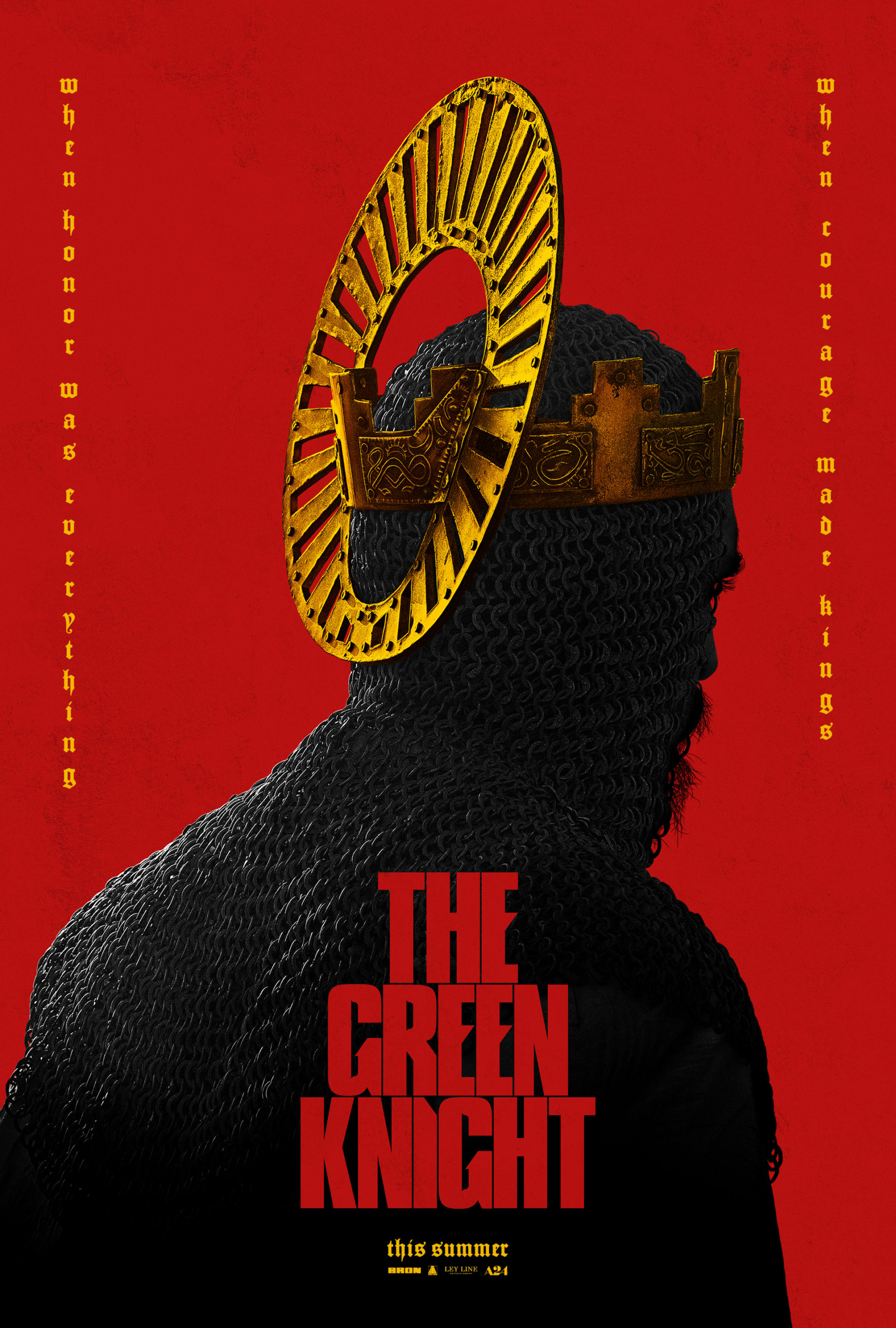
30 Jul The Green Knight Review
THE GREEN KNIGHT
dir. David Lowery, starring Dev Patel, Alicia Vikander, Sean Harris, Joel Edgerton, Sarita Choudhury, Ralph Ineson, et al
Expectations are a tricky thing. On the one hand, an audience can hype up a project to the point where the finalized product can’t possibly measure up to said expectations, leaving the viewers disappointed, jilted, even angry (whether they realize this partly due to their own projections is entirely up to them). On the other, when those impossibly high expectations are met, the resulting elation can only be described as an orgasmic release of triumph, satisfaction, validation, or some combination of the three. Such is the case of The Green Knight, one of many films delayed due to COVID that spent a year languishing as fans of A24 and high fantasy were left with naught but a mesmerizing trailer to keep them nourished.
The Green Knight presents Gawain, nephew of King Arthur, who desires to be a knight with great tales to tell. The opportunity for just that presents itself at the Yuletide celebration, held by Arthur, Guinevere, and the knights of Arthur’s table. The Green Knight, an earthy creature born of witchcraft, invites a knight of Arthur’s stable to strike him under the condition the knight is willing to receive the same blow in one year’s time. Eager to prove himself, Gawain accepts and proceeds to lop the being’s head clean off, only for the knight to retrieve his head, remind Gawain of their agreement, and ride off into the mist. From there, Gawain’s true colors are revealed a year later as his quest to uphold his end of the bargain begins.
Phrases like sumptuous feast for the eyes and an epic journey of self discovery will be tossed around in most reviews and these are definitely true. The Green Knight is not the action packed, glorious triumph of David over Goliath movie that some seem to want it to be; anything distributed by A24 is guaranteed to have deeper purpose than that. The Green Knight is working on multiple levels, but at the forefront is Gawain’s journey for purpose in life as he strives to become a better version of himself. Absent are the tropes normally associated with King Arthur and the knights: there’s no shiny armor or court intrigue to engage the audience. The focus is almost solely on Gawain throughout, navigating the landscape of medieval England to reach the end of his journey and fulfill his end of a bargain. Themes of religion, of duty, and what it means to be a knight are repeatedly presented to Gawain as he’s tested time and again along his travels. His sojourn ends with a 10 minute near-silent montage that’s beautiful, terrible, haunting, and cautionary.
Put short, The Green Knight is a brilliant piece of filmmaking that will surely go down as one of the all-time great entries in the Fantasy genre.
Dev Patel is front and center as Gawain, appearing in nearly every frame of the film. Subtlety is the name of the game in this movie; just as much is conveyed in looks and glances than is actually said. To that end, Patel’s performance is captivating as Gawain, a man who wants sorely to become something he doesn’t fully understand or appreciate. Patel portrays Gawain as a cowardly man, carefree and immature who, despite claiming he wants to be a knight, shows no examples of behavior befitting the rank he seeks. This runs throughout the course of the movie, culminating in a make-or-break moment that elevates Patel’s performance and the film as a whole. Alicia Vikander in a dual role plays both temptress and commoner as she represents two different facets of Gawain’s inability to grasp the complexities of knighthood. Vikander’s portrayal of both is varied as the commoner lays her wants and hopes bare to Gawain while the Lady is played as more sly, cunning, and ultimately another subject of Gawain’s impropriety. Sean Harris’ Arthur is portrayed as a weary, weakened monarch, frail of both body and voice. Harris never raises above a whisper as he interacts with Gawain, setting him on a quest with what could be construed as having ulterior motives.
Joel Edgerton also makes an all too brief appearance partway through the second act as the Lord of a keep. His performance as an affable, friendly, almost easygoing character is a stark contrast to what’s come before in the film and almost serves as something of a relief. The Lord’s openness is a direct contrast to his Lady’s shrewdness; it’s unfortunately that while the two share the screen on a handful of occasions, the interaction between the two is almost nonexistent. The significance of the Lord and Lady’s One Final Test of Gawain shouldn’t be lost on the audience; the stellar performances of Edgerton and Vikander more than sell the characters even with minimal screen time. With regards to a reduced presence on screen, Kate Dickie, Sarita Choudhury, Barry Keoghan, and Erin Kellyman all have a handful of scenes that are superbly filled out; no role is too small in The Green Knight. Keoghan and Kellyman serve as tests on his journey, with varying levels of success. Keoghan brings a rascally bend to his Scavenger while Kellyman has a haunting, yet at times almost comical portrayal of Winifred, a decapitated virgin who serves as something of a parallel for Gawain. Sarita Choudhury as Morgan Le Fay, Gawain’s mother, wrings plenty from her time on screen; with few words spoken, Morgan’s impact on the story is felt through Choudhury’s quietly strong performance as both a concerned mother and something more powerful.
That leaves Ralph Ineson as the Green Knight. High in the running for character with a movie named after them yet having the least amount of screen time, Ineson’s performance as a creature borne of the earth is imposing, solemn, and haunting. A lesser film might’ve served to depict the Green Knight as the antagonist of the film; Lowery avoids that pitfall and instead uses the character as an agent of change. Due to the heavy amount of makeup, Ineson is unable to do much in the way of facial acting; therefore his famously gravelly voice his main instrument. Ineson’s voice booms and reverberates in each scene, accompanied by the crushing sounds of his footsteps that remind the viewer of his looming presence even when off screen for the vast majority of the film.
Directed by David Lowery, who came to prominence with 2013’s Ain’t Them Bodies Saints, The Green Knight is a technical marvel on every conceivable level. By blending the past its prime design of Camelot with the aging, perennially exhausted looks of King Arthur and Queen Guinevere, Lowery and his team succeed in showing a less romanticized version of the mythical castle and court within. Almost reminiscent of the gloomy elven stronghold Rivendell from Fellowship of the Ring, the drab setting of Camelot washed in flat, cold greys evoke a feeling of a city on the decline with its monarch as the living embodiment of the lack of vitality. At 130 minutes, Lowery allows the film to move at its own pace, allowing Gawain a side quest or two as he labors his way to the Green Knight’s abode. By letting the film breathe, Lowery allows for Gawain’s character development, giving him opportunities to grow and change, as he remains steadfast in his quest. While the pacing may seem slow for some, it allows the audience to live in the mythical world that hasn’t been rendered quite like this on screen before. Due largely in part to cinematographer Andrew Droz Palermo, the look of The Green Knight is one of the main appeals of the film. Captured in dazzling clarity, the colors of the film oscillate between drab greys, lush greens, and the occasional eye-popping yellow. The colors, along with the cinematography and production design combine to create an ethereal, dream-like feel throughout much of the film. If The Lord of the Rings was the previous benchmark for high production fantasy in film, it finally has competition two decades later.
Acknowledgement has to be given to the makeup and costuming, as well. While science fiction and fantasy films (and of course the Academy beloved period pieces) offer some the best opportunities for costumers and makeup artists to flex their skills and shine, the crew of The Green Knight went above and beyond. The sunken, hollowed eyes of both Arthur and Guinevere help paint the picture of how far from grace Camelot has fallen. The decisions to garb Patel’s Gawain with the brilliant yellow cloak that stands out against the oppressively dour atmosphere ensures the audience’s eye is on him at all times. The titular Green Knight himself is a fantastic design, decking out Ralph Ineson in something not quite Groot and not quite Treebeard. The imposing figure of the Green Knight in all his elemental glory is aided by the sound design’s constant creaking and groaning as he moves, displaying how each department of this movie was in perfect lockstep with the others.
While the religious themes are played (not so) subtly throughout the film, they’re never more overt than they are in the score for The Green Knight. While some scores strive to direct and manipulate the viewer’s feelings in any given scene, composer Daniel Hart eschews that tactic to underscore Gawain’s initial lack of faith which develops throughout the film. With its echoing choirs belting out something akin to pious hymns, the score could be just as much at home in an ancient cathedral as it is in a theater (for some, those two locations are one in the same).
Overall, The Green Knight is more than just a sight to behold on the biggest possible screen. The Green Knight is an experience. The journey Gawain (and through him the viewer) embarks upon serves a dual purpose: a literal quest worthy of glory every knight aspires to attain to, but more importantly it forces Gawain to reflect inward and discover what kind of man he is and what kind of man he has the potential to become, for good or worse. In an age where superheroes and overly produced slick CGI blockbusters are king atop the mountain, the reflective, cerebral nature of The Green Knight combined with its almost lackadaisical pacing will guarantee it’s not a film for your everyday moviegoing audience. Still, for those who’ve hungered for a mature fantasy story since the lackluster ending of the show-that-shall-not-be-named, The Green Knight is the perfect vehicle to get swept up and immersed in. Outstanding performances, top notch directing, a mood setting score, uncanny production design, and what might be one of the best final lines from a film in recent memory, The Green Knight is the best film of 2021 thus far.
Review by Darryl Mansel


No Comments